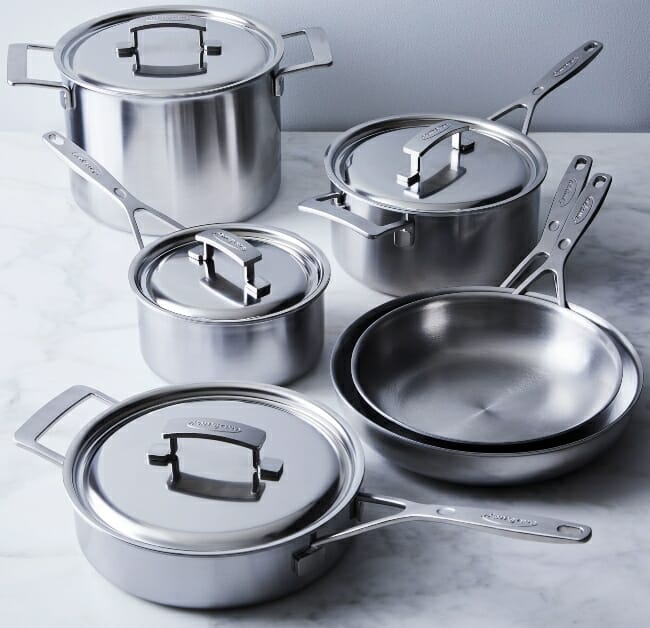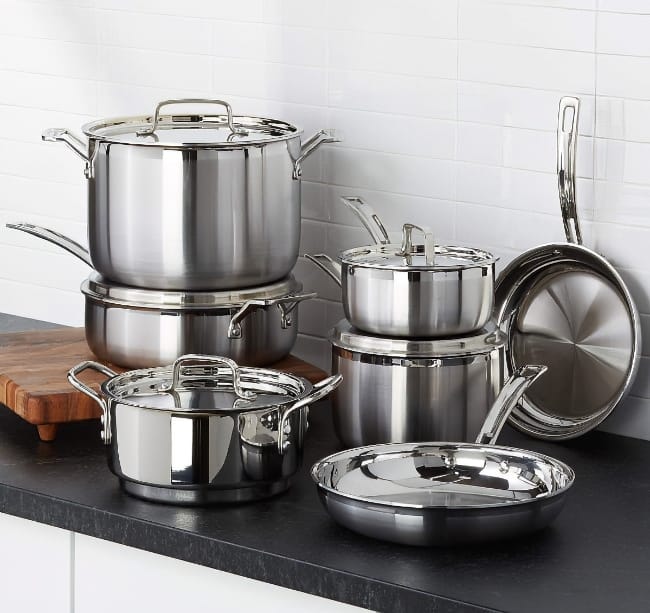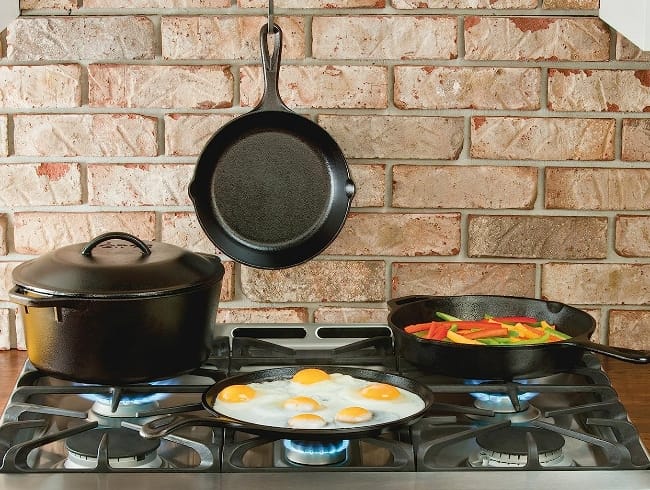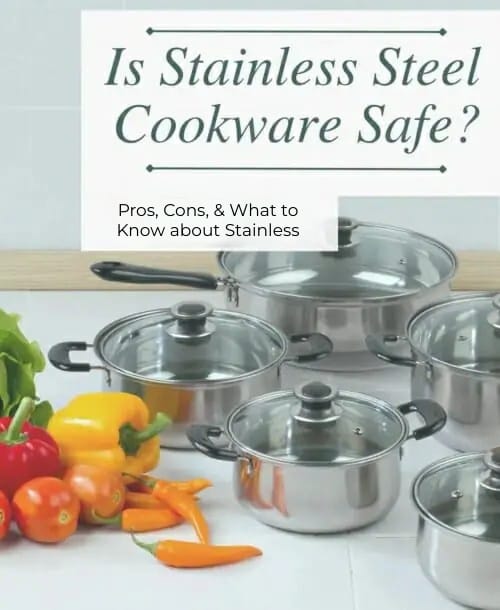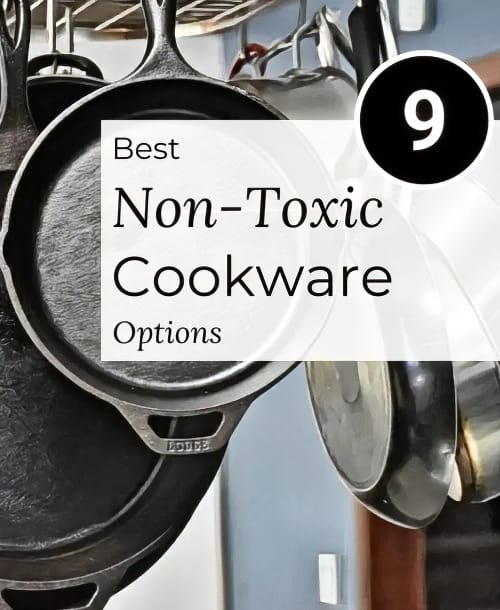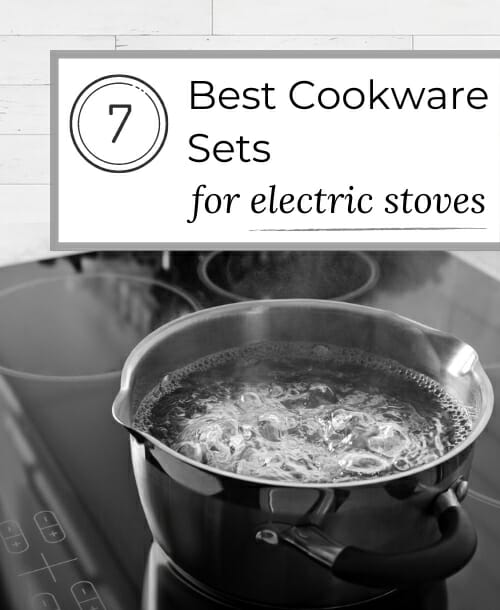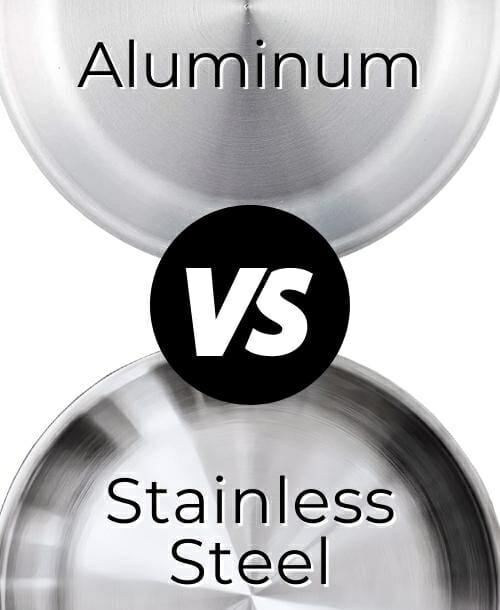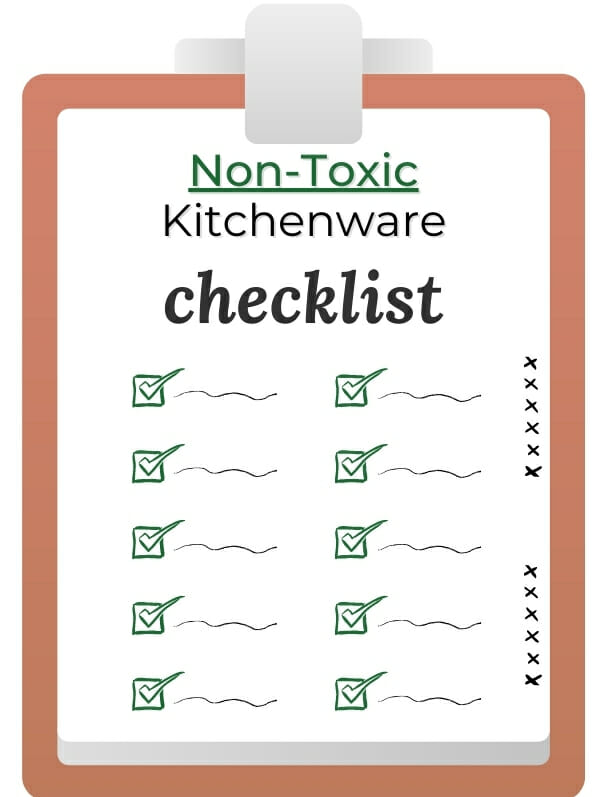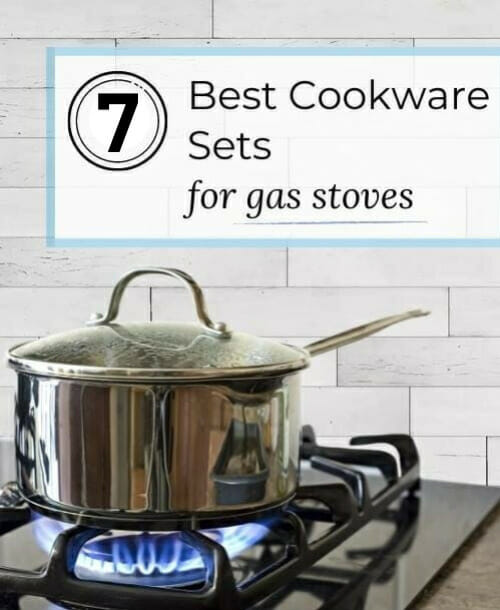
Gas stoves, known for their rapid heating and precise temperature control, demand cookware that can handle intense, center-focused heat. While any pan “works,” the wrong choice risks burning, warping, and scorching food directly over the burner.
The best cookware for gas stoves should spread heat evenly to the rim, retain heat for consistent, even cooking, and boast a thick base. One prime example is 5-ply stainless steel cookware.
After extensive research and testing, we identified seven cookware options that excel on gas cooktops. These include stainless steel, non-stick, carbon steel, and cast iron picks.
We’ll discuss why each option works great on gas, its performance in various cooking tasks, potential drawbacks, and more.
Use the green navigation bar below to jump around. Let’s get started!
Our Top Picks (& Why): At a Glance
1. Best Overall: Demeyere 5-Plus
Why: Its 5-ply design perfectly balances heat retention and conduction, and its “stay-flat” base doesn’t warp. (Jump to Review)
2. Best Stainless Steel: All-Clad D5
Why: Its 5-ply design with a robust steel core achieves unrivaled heat retention in a stainless steel pan. (Jump to Review)
3. Best Value: Cuisinart Multiclad Pro
Why: Its high-quality 3-ply build offers precise heat control and incorporates a warp-resistant base at a low cost. (Jump to Review)
4. Best Non-Stick: Made-In 5-Ply
Why: Its unique 5-ply design surpasses all other non-stick pans I’ve tested in heat retention and durability. (Jump to Review)
5. Best Ceramic Non-Stick: Greenpan GP5
Why: Its extra-thick hard-anodized body and “stay-flat” base for optimal heat conduction and durability. (Jump to Review)
6. Best Cast Iron Set: Lodge Cast Iron
Why: Unrivaled heat retention for consistent heating and rugged durability at a low cost. (Jump to Review)
7. Best Carbon Steel: Lodge Carbon Steel
Why: Rugged durability alongside a more balanced heating speed and retention, compared to cast iron. (Jump to Review)
7 Best Pots and Pans for Gas Stoves | Tested & Reviewed
Now, let’s dive deep into the seven best pots and pans sets for gas stoves. We’ll cover the details that make each set a standout gas stove option.
1. Demeyere 5-Plus
Best Overall Cookware Set for Gas Stoves
- Materials & construction: 5-ply, fully-clad; Brushed 18/10 stainless steel exterior, lids, & handles. Triple aluminum core. 18/0 stainless steel base (induction-compatible)
- Set: 10pc (six pots & pans, four lids – see sizing)
- Compatibility: Works on all cooktops; oven & broiler-safe to 500℉ (incl. lids). Metal utensil safe.
- Dishwasher-safe? Yes, but I recommend hand-washing
- Where it’s made: Belgium
- Price when published: $999.95 (Check Latest)
- Lifetime warranty
We chose Demeyere for its 5-ply, triple aluminum core design, which perfectly balances heating speed and hot-spot-free retention; its easy-cleaning Silvinox finish; and its “stay-flat” base.
Due to its poor heat conductivity, food often sticks to single-layer stainless steel cookware. And while 3-ply pans heat evenly, I’ve found them less forgiving and easier to burn food on gas stoves.
Yet Demeyere’s 5-ply construction delivers an evenly heated, stable cooking surface that’s more forgiving than 3-ply. While slightly less heat retention than All-Clad’s D5 steel core, Demeyere’s triple aluminum cladding responds faster to stove adjustments, ideal for delicate recipes.
Each pan’s “stay-flat” base prevents bulging during rapid heat changes, ensuring uniform cooking, and the brushed finish conceals stove grate scratches.
But Demeyre’s standout feature is its Silvinox finish, combating food sticking and discoloration common in gas stove use.
Enhancing the cooking experience are steel handles with large V-shaped diffusers that stay cool despite flame “spillover.” The handle’s rivetless design simplifies cleanup, and each pan but the skillets includes a stainless steel lid (broiler-safe to 500℉).
Overall, Demeyere’s 5-Plus is a well-thought-out collection with gas stove users in mind, earning it my top spot.
- Perfectly balances heat retention and conduction
- Silvinox treatment fights sticking and discoloration better than competing pans
- Rugged “stay-flat” base to prevent warping
- Rivetless, heat-vented handles for easier cleaning and comfort
- Lifetime warranty
- Less heat retention than steel core pans like All-Clad’s D5
- Expensive
- Stickers that come on the pans can be hard to remove
- Fry pans do not include lids
2. All-Clad D5
Best Stainless Steel Cookware for Gas Stoves
- Materials & construction: 5-ply, fully-clad; Brushed 18/10 stainless steel exterior & handles. Dual aluminum layers. Steel core. 18/0 stainless steel base (induction-compatible)
- Set: 10pc (six pots & pans, four lids – see sizing)
- Compatibility: Works on all cooktops; oven & broiler-safe to 600℉ (incl. lids). Metal utensil safe.
- Dishwasher-safe? Yes, but I recommend hand-washing
- Where it’s made: USA
- Price when published: $735 (Check Latest)
- Lifetime warranty
We chose All-Clad D5 for its alternating steel and aluminum layers with a solid steel core for excellent heat retention and warp-proof durability.
All-Clad’s D5 stainless impressed me. While less responsive to heat adjustments than the D3, D5 Copper, or Demeyere, I’ve found the D5’s steel core excels at absorbing and retaining heat. This ensures even cooking, minimizing the risk of sticking or burning—crucial for the temperature fluctuations of gas stoves.
Yet, you don’t sacrifice control in precise cooking tasks, as the dual aluminum layering spreads heat much quicker than my cast iron pan.
A reinforced 18/0 steel base works with the core to effectively prevent warping, offering peace of mind through frequent hard use.
Also, the D5’s extra-long vented steel handles kept my hand comfortably away from the flame. And rugged stainless steel lids, broiler-safe up to 600°F, proved to be a highlight for braising.
Overall, All-Clad’s D5 is a solid choice for precise, reliable, and forgiving cooking on gas stoves.
- Heat-retaining steel core for more uniform heating and warp-resistance
- Thick, reinforced base prevents warping
- Extra long, heat-vented handles stay cool
- Extra-high 600°F heat tolerance for oven and broiler use
- Lifetime warranty
- Easier sticking/ more challenging to clean than Demeyere 5-Plus
- Expensive
- The pan edges can be a bit sharp (possible QC issue)
- Fry pans do not include lids
3. Cuisinart Multiclad Pro
Best Value Cookware Set for Gas Stoves
- Materials & construction: 3-ply, fully-clad; Brushed 18/10 stainless steel exterior, handles, & lids. Aluminum core. 18/0 stainless steel base (induction compatible)
- Set: 12pc (six pots & pans, steamer basket, five lids – see sizing)
- Compatibility: Works on all cooktops; oven & broiler-safe to 550℉ (incl. lids). Metal utensil safe.
- Dishwasher-safe? Yes, but I recommend hand-washing
- Where it’s made: China
- Price when published: $207.99 (Check Latest)
- Lifetime warranty
We chose the Multiclad Pro due to its precise heat control for delicate recipes and rugged base – comparable to All-Clad’s D3 for a fraction of the price.
Despite being 3-ply, the Multiclad Pro stands out as a top performer for gas stoves under $300.
After testing it alongside All-Clad’s D3, I found no notable difference in heat response. All-Clad was slightly easier to clean, but the Multiclad Pro’s steeper sides proved helpful in preventing spillover. Everything else is pretty even.
Like the D3, Cuisinart’s Multiclad Pro features an 18/10 interior and hardened steel base, armoring the pan against flame damage and warping. The aluminum core, stretching from center to rim, effectively carries heat throughout the pan in real time, preventing hot spots.
While 3-ply doesn’t match 5-ply’s heat retention, it excels in precise cooking tasks that demand heat control (sear-to-simmer, for example). However, it’s less forgiving if you accidentally twist the dial too high, making it easier to burn food.
Other features enhance its performance on gas stoves. These include vented steel handles to dissipate excess heat and rugged stainless steel lids (broiler-safe to 550℉). While the skillets lack lids, the 3-quart saucepan lid fits the 10”, and the steamer cover fits the 8”.
- 3-ply with aluminum core for faster, more precise heat response than 5-ply pans
- Thick, reinforced base prevents warping
- Heat-vented handles for comfort
- Affordable, high-quality set with a lifetime warranty
- More prone to warping than 5-ply pans
- Less heat retention than 5-ply; food sticks and burns more easily
- Skillets do not include lids
4. Made-In 5-Ply Non-Stick
Best Non-Stick Cookware for Gas Stoves
- Materials & construction: 5-ply, fully-clad; Stainless steel exterior & handles. Triple aluminum core. 430 stainless steel base (induction compatible). Teflon coating
- Set: 3pc (8”, 10”, & 12” frying pans)
- Compatibility: Works on all cooktops; oven-safe to 450℉
- Dishwasher-safe? No, hand-wash only
- Where it’s made: Italy
- Price when published: $343 (Check Latest)
- 1-year warranty
We chose Made-In for two reasons: its unique 5-ply design, which offers better heat retention and warp resistance than any other non-stick pan I’ve tested; And its long-lasting 2-layer coating, designed for commercial kitchens to withstand rugged gas stove use.
Most non-stick pans are alike, but our original pick went to All-Clad’s HA1 due to its extra-thick, hard-anodized body. However, after testing them out, Made-In’s 5-ply non-stick pans changed my mind.
Their 5-ply design mirrors Demeyere 5-Plus with the addition of a non-stick coating.
Its rugged stainless exterior with hardened base outperforms standard hard-anodized pans in terms of warp resistance. The 5-ply build also improves heat retention, vital for cooking evenly with center-focused gas burner heat. And its triple-layer aluminum core ensures you keep the quick, even heating characteristics of standard hard-anodized pans.
Paired with a professional 2-layer non-stick coating, it made cooking sticky eggs a breeze. Cleanup was even easier.
Now, All-Clad’s HA1 offers similar non-stick performance. But Made-In’s pans (and coating) are manufactured in Italy, where I better trust PTFE safety over HA1’s Chinese manufacturing. That said, I still recommend the HA1 for those seeking a complete set with stocktops, saucepans, and more, as it’s another top performer around the same cost.
- Retains heat better and cooks more evenly than hard-anodized pans
- Triple aluminum core for responsiveness
- Thick, reinforced base prevents warping
- Professional 2-layer non-stick coating for long-lasting hard use
- Upward-angled handles to keep your hand away from the flame
- Not metal utensils or dishwasher-safe
- Surpassing its max temperature of 500℉ can cause the PTFE coating to break down
- Using higher than medium stove settings can overheat the Teflon coating
- Non-stick coating only lasts a few years
5. Greenpan GP5
Best Ceramic Non-Stick for Gas Stoves
- Materials & construction: 5mm-thick, heavy-gauge hard-anodized aluminum. Ceramic non-stick coating. Reinforced Magneto base (induction-compatible)
- Set: 11pc (5 pots and pans, 3 lids, 3 utensils & pan protectors – see sizing). Individual pieces available.
- Compatibility: Works on all cooktops; oven-safe to 600℉
- Dishwasher-safe? Yes, but I recommend hand-washing
- Where it’s made: Italy & China
- Price when published: $860 (Check Latest)
- 2-year warranty on coating; lifetime on pan body
We chose the GP5 for its Teflon-like ease without harmful fumes if overheated and its extra-thick hard-anodized body with “stay-flat” base, ensuring optimal heat conduction and durability.
The primary concern with Teflon pans, especially on fast-heating gas stoves, is the risk of harmful fumes if overheated. That’s one reason GreenPan’s GP5 made our list.
Its Infinit8 ceramic nonstick coating provides complete safety without sacrificing non-stick ease. While any ceramic pan shares this advantage, the GP5 stands out with its multi-layered, diamond-infused ceramic for improved longevity.
But what sets the GP5 apart for gas stove use is its impressive 5mm double hard-anodized body—Greenpan’s thickest to date—and its Balance Pro Magneto base.
Thin, hard-anodized pans tend to over-conduct, burning food and warping. Yet the GP5’s thickness ensures durability and sufficient heat retention to prevent hot spots. Like Demeyere, its reinforced stay-flat base flexes rather than permanently warping under extreme heat fluctuations. Also, I love the base’s dark, textured surface as it hides light scratches from stove grates.
The GP5’s vented steel handles effectively diffuse escaped heat, getting warm but not hot. And they’re rivetless for easier cleanup! While pricey, the GP5 is the best ceramic option I’ve found for durable, reliable gas stove use.
- Extra-thick body for optimal heat retention and cooking stability
- Balance Pro base prevents warping with intense heat swings
- Dark color hides stove grate scratches and discoloration
- Multi-layered, PFAS-free ceramic coating for improved lifespan, safety, and heat tolerance
- Rivetless, heat-vented handles for easier cleaning and comfort
- Not metal utensil or dishwasher-safe, despite being labeled so
- Ceramic non-stick coating only lasts a few years
- Isn’t as non-stick as Teflon
- Pricey for non-stick
6. Lodge Cast Iron
Best Cast Iron Cookware Set for Gas Stoves
- Materials & Construction: One-piece build including handles; 100% cast iron (pre-seasoned)
- Set: 5pc (2 skillets; 1 griddle & 1 Dutch oven – see sizing)
- Compatibility: Works on all cooktops; oven & broiler-safe to 650℉ (incl. lids). Metal utensil safe.
- Dishwasher-safe? No, handwash and dry
- Where it’s made: USA
- Price when published: $89.90 (Check Latest)
- Lifetime warranty
We chose Lodge cast iron for its extreme durability, versatility, and unrivaled heat retention for the most uniform heating surface possible; and a less-stick seasoning layer that safely withstands rugged use.
Lodge’s 12″ skillet has been my kitchen staple for years. Crafted from thick, pure iron in the US for over a century, Lodge’s cast iron set is unrivaled at this price point. Despite its weight and slow-heating nature, cast iron shines on gas stoves for its exceptional heat retention and durability.
Preheating cast iron allows it to absorb heat like a sponge, ensuring even distribution across the cooking surface. Its slow-cooling nature provides unmatched heating stability, preventing scorched food and sticking despite gas stove temperature swings. Just note that cast iron’s heat retention makes sudden heat adjustments for precise recipes challenging.
Yet cast iron’s standout feature is its natural seasoning layer. It provides a coating-free, stick-resistant (and metal utensil-safe) surface that never emits fumes if overheated. Though Lodge comes pre-seasoned, I recommend an additional round for optimal non-stick egg cooking, like this.
Beyond its performance, this set’s thoughtful details, like pour spots and helper handles, contribute to easier washing and serving. While the vented helper handles stay cool, the main handle doesn’t, so I recommend handle sleeves.
- Better heat retention than any other material; highly stable cooking surface
- Less-stick surface that lasts for life without coatings
- Versatile heat tolerance (650°F) and rugged; won’t warp
- Rivet-free, one-piece design for durability and easier cleanup
- Dark color hides stove grate scratches and discoloration
- Heats slowly; sluggish responsiveness
- Heavy
- The main handle gets hot
- Requires handwashing and drying; seasoning maintenance
7. Lodge Carbon Steel
Best Carbon Steel Pan for Gas Stoves
- Materials & Construction: 100% carbon steel (pre-seasoned), including riveted handle
- Set: Single 12” skillet (multiple sizes available
- Compatibility: Works on all cooktops; oven & broiler-safe to 650℉. Metal utensil safe.
- Dishwasher-safe? No, handwash and dry
- Where it’s made: USA
- Price when published: $44.90 (Check Latest)
- Lifetime warranty
We chose Lodge carbon steel as it’s similar to cast iron but in a lighter weight, faster-heating design. It offers more balanced heating speed, retention, and overall versatility on gas stoves.
Like their cast iron, Lodge carbon steel pans offer top quality at an affordable price. This pan, too, has a less stick surface that improves over time, extreme durability, and high heat tolerance for complete stovetop to oven freedom.
But carbon steel’s responsiveness for delicate recipes sets it apart for gas stove use.
The thinner design offers more control than cast iron, responding faster to heat adjustments. Just note heat retention does suffer a bit, so burning food is a tad easier… I’d liken this pan to 5 or 7-ply stainless steel in terms of even heat conduction, but with less sticking thanks to the seasoning layer.
This makes carbon steel an excellent choice for those seeking to ditch non-stick pans without committing to stainless steel or cast iron.
Comfort features, like the extra long, upward-angled handle, safely keep your hand away from the flame. However, I recommend a handle sleeve as this handle can get hot during extended uses.
- Greater versatility than cast iron; overall more balanced heating
- Lighter-weight than cast iron yet highly warp-resistant
- Pre-seasoned, less-stick surface that lasts for life without coatings
- Extra-high 650°F heat tolerance for oven and broiler use
- Dark color hides gas stove grate scratches and discoloration
- Extra long handle for comfortable gas stove use
- Less heat retention and stability than cast iron; easier food sticking
- Requires handwashing and drying; seasoning maintenance
- The riveted handle is not as durable as a one-piece construction
What to Look For in Cookware for Gas Stovetops: Criteria

Unlike electric stoves, which apply heat gradually through the coils, gas stoves emit intense and immediate heat to the pan through an open flame. This sudden heating offers more precise control over cooking temperatures. However, it can easily warp and discolor pans, producing unevenly-cooked or burnt food.
While any pan is technically compatible, the best pans for gas stoves should meet the following heating and durability criteria:
Heat Conduction & Retention
For gas stove use, effective heat conduction boils down to three factors. The pan should:
- Distribute heat evenly without hot spots: Cooking relies on the heat in the pan, not the flame. It’s the pan’s job to spread the center-focused heat from gas burners. Avoid cookware that’s too thin, as it’ll scorch food directly under the burner.
- Adjust temperatures without damage: Gas stoves provide instant heat adjustments. So, the pan should withstand these temperature changes without damage.
- Retain heat for even cooking: A pan’s ability to hold heat, typically achieved with thickness, ensures consistent and even cooking. Inadequate heat retention results in unsteady pan temperatures and sticking.
Thin aluminum pans heat up fast but tend to over-conduct, leading to burns on both the pan and food.
In contrast, cast iron retains heat well for uniform cooking but responds slowly to heat changes. Carbon steel strikes a better balance with its thinner, faster-heating design, though still relatively sluggish.
The ideal choice for balanced heat conduction is “fully-clad” stainless steel cookware, available in 3-ply, 5-ply, and 7-ply varieties. Fully clad pans contain bonded layers of aluminum or copper, encased in a stainless steel exterior that withstands gas flame abuse.
I recommend 5-ply for its optimal combination of fast, even heating and forgiving heat retention. 3-ply heats fast, but its thin design sacrifices heat retention (easier to burn food). While 7-ply retains heat beautifully, I’ve found its thickness to cause a sluggish heat response.
For those preferring non-stick options – thick, hard-anodized aluminum pans like GreenPan’s GP5 above are suitable choices.
Durability & Comfort
For gas stove cookware, it’s essential to prioritize durability, as the wrong pan can warp and discolor from the intense heat. Look for:
- Thicker pans and hardened bases: Opt for 5 to 7-ply stainless steel, cast iron, or carbon steel pans, as thicker options resist warping from intense heat and provide consistent heating. Pro tip – check for induction-compatible cookware bases. They’re usually thick, hardened steel that’s stronger than non-magnetized bottoms.
- Durable, heat-resistant handles: Gas stove flames pour excess heat up around your pan’s edges, heating the handles. Riveted steel handles with V-shaped heat diffusers ensure comfort and longevity (won’t melt like plastic handles). Longer handles are preferable to keep away from the flame.
- Darker-colored exteriors: Gas stoves can easily discolor pans, and the grates can scratch their bottoms. Avoid mirror-polished finishes; aim for brushed exteriors like All-Clad’s D5 to help conceal scratches. When applicable, aim for darker colors such as black, gray, or Navy blue, as they better mask flame-induced discoloration.
- Quality materials & strong warranties: Select cookware with high-quality materials and craftsmanship. Look for strong warranties as a key quality indicator, with most of our picks above featuring lifetime coverage.
Once again, multi-layered stainless steel (5-ply), thick hard-anodized, and carbon steel/ cast iron pans are ideal for gas stove durability.
Gas stove-specific criteria aside, the following general considerations can help you make a better cookware purchase:
Other Cookware Considerations
- Lid type: Stainless steel lids are durable and boiler-safe, while glass lids provide easy food monitoring to prevent overcooking.
- Dishwasher-safety: “Dishwasher-safe” pans can save you time, but I recommend handwashing. Stainless steel may cloud, and non-stick pans lose performance from dishwasher use. That said, stainless is the only material I’d consider suitable for the dishwasher.
- Sets vs. individual pots and pans: Assess whether a complete high-end cookware set is necessary. Often, one or two high-quality workhorse pieces (like a 5-ply steel skillet and saute pan) will suffice. Add a lower-cost hard-anodized pan for sticky foods, then gradually expand your collection based on your needs.
FAQs
Is nonstick cookware safe for gas stoves?
Yes, non-stick pans are generally safe for gas stoves. However, use caution. Most non-stick pans are made of aluminum or stainless steel coated in PTFE. Avoid using high heat with Teflon cookware to prevent overheating the coating, which could release potentially harmful fumes and damage the pan.
Can ceramic be used on gas stoves?
Yes, you can use both pure ceramic and non-stick ceramic cookware on gas stoves. If using pure ceramic, avoid setting a hot pan on a cool countertop to prevent thermal shock breakage. And avoid using high heat with non-stick ceramic, as it can damage the coating.
Can you use cast iron skillets on a gas stove?
Yes. Despite cast iron’s weight and slower heating, it’s an excellent choice for gas stoves due to its exceptional heat retention, tolerance, and durability. Preheating cast iron for several minutes ensures even heat distribution, keeping pan temperatures consistent for evenly-cooked meals.
What pans should not be used on a gas stove?
Avoid using the following pans on a gas stove:
- Thin aluminum pans: These can warp, burn, and discolor easily. Examples include inexpensive, lightweight non-stick pans.
- Cheap, single-layer stainless steel pans: They conduct heat poorly, causing hot spots and uneven cooking.
What kind of cookware is best for a gas stove?
The best cookware for a gas stove is fully-clad stainless steel with a 3-ply construction minimum. 5-ply is ideal for optimally balanced heat conduction and retention. Cast iron and carbon steel also work well, with carbon steel offering faster, more versatile heat response. For non-stick options, prioritize thick, hard-anodized pans.
Recap & Conclusion
To recap, selecting the best cookware for gas stoves involves a careful consideration of heat distribution, retention, and overall durability.
Our testing process, combining in-house evaluations with extensive historical experiences, helped us identify top-performing sets that meet these criteria. We also weighed strong warranties, brand reputation, and manufacturing standards to ensure the best quality.
Here’s a final recap of my top three recommendations from our list and why:
- Demeyere’s 5-Plus emerged as my top choice, impressing me with its 5-ply design, triple aluminum core, and warp-resistant base. I found Demeyere easier to use, clean, and cook with than similar options. And its balanced heating offered me more cooking versatility.
- For those on a budget, Cuisinart’s Multiclad Pro stands out as a cost-effective yet high-quality option, comparable to All-Clad’s D3. Its 3-ply design delivers responsive heat adjustments, granting more control during cooking. And the reinforced base adds an extra layer of durability, preventing warping over time.
- All-Clad’s D5 leans more on the heat retention side, heating slower than Demeyere but maintaining an overall steadier cooking temperature thanks to its steel core. This set offers more *cast iron-like browning and searing (*with less upkeep) than faster-heating pans like Demeyere 5-Plus and Multiclad Pro.
Happy Cookin’
P.S. Some cookware works better on gas stoves than others, and some pans are safer for your health than others. Check out our non-toxic cookware guide to discover which pans you should avoid and why.

Hi there! I'm Adam, author and founder of TGL. Since 2016, I've produced and sold non-toxic kitchenware throughout the US. Today, I'm using my passion and experience in sustainable product manufacturing to help families avoid unsafe reusable foodware. When I'm not writing, you'll find me hiking or camping throughout Appalachia!
Enjoyed this post? Share it with your friends!
Related Posts
FREE Guide
Non-Toxic Kitchenware Checklist
Get a step-by-step product guide with insider tips & tricks for the safest kitchen possible!

